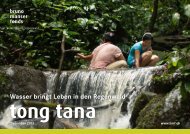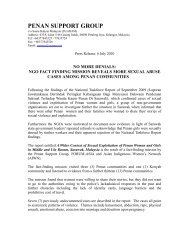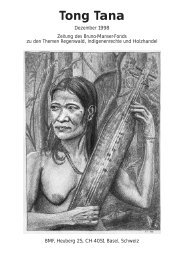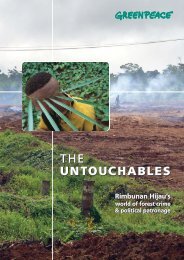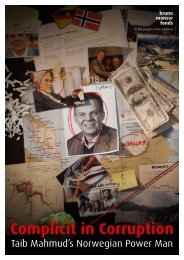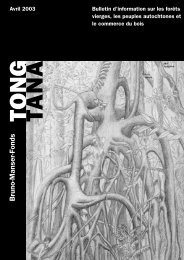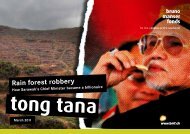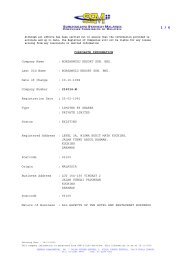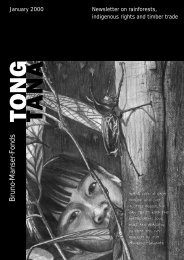International6 Tong Tana April 2003Massive criticism of FSCjrd – The Forest Stewardship Council (FSC) awards itslabel to forest industries, timber works and traders“guaranteeing” the labelled wood products as derivingfrom environmentally appropriate, sustainable andsocially beneficial forest management. The BritishRainforest Foundation recently published a report*describing 9 cases from all over the world demonstratingserious flaws in the claims of the FSC and the necessityfor fundamental reforms if the FSC is to upholdits own standards and the public’s expectations. Negativeexamples such as that of an Indonesian teakplantation company’s certification being withdrawn(see Tong Tana, Aug. 2001, p. 6/7) harm the FSC’sreputation.According to the Rainforest Foundation the followingpoints undermine FSC’s performance:– Of greatest importance to the whole organisationis the accreditation contract which regulates therelationship to FSC certifiers and is only intendedfor internal use! The actual on-site controllers ofthe forest industries and sales routes are thecertifiers (for ex. SCS, Smart Wood) with FSCauthorisation, who award the label according totheir own specifications.Because of their economic significance thesecertifiers are hardly controlled, let alone punishedfor violations of the FSC principles and criteria.– The greater the area these “independent” certifierscan certify, the higher their income, which maylead to a conflict of interests with the strict FSCstandards. They do place conditions which must befulfilled by the to be certified company inside agiven time-span but are not interested in rejectingapplications for certification. Such admittancesbased on a sitting back and watching attitude leadin the best case to some future improvement intimber production, while the products are alreadysold with the FSC logo!– The certifiers differ in their interpretation andapplication of the FSC principles and criteria.Additionally, involved experts who control a companyon-site have no possibility of enforcing theirrecommendations (due to the requirements ofconfidentiality); decisions are made by the managementof the certifier.– Due to competition with other certification systems,usually issued by the industry, the FSC hasdecided on the strategy of speedily enlarging theirown areas which puts people under pressure,leads to the standards being undermined (for ex.the percent clause), and to promises beingaccepted instead of actual management improvements– generally putting quantity over quality. TheFSC standards are the strictest. It is thereforequite complex and expensive to attain the label.Therefore it will never be able to compete againstless strict labels as far as quantity is concerned.– Due to trade groups mainly supported by the WWF,who wish to sell only FSC wood products, a demandis being created which can hardly be satisfied withwood from good sources. Therefore the FSC certifiedforest areas must be enlarged in order tosupply enough FSC wood!– This system of principles and criteria lacks a clearunambiguous definition of “major failures” (oncompany level as well as due to governmental baseconditions) which prohibit certification.The initial interest in certification was caused byappeals to boycott tropical wood or wood productsfrom overexploitation: suppliers, government authoritiesand retailers wanted to go on offering a big rangeof wood products without continuously being confrontedby campaigns and complaints. But one of thefundamental problems in the certification of wood andwood products is that the additional profit margin isrelatively small. Therefore companies look for cheaplabels, or less strict certifiers, or even play one certifieroff against another.The authors reach the conclusion that in the course ofthe last couple of years the FSC has developed from anorganisation which fought for better forest managementinto a marketing tool for better sales of woodproducts. They propose massive reforms, for example,that the FSC office itself (together with teams on anational level) award the label and dispense with thecertifiers. They hope with these and other measuresfor greater transparency and more democracy in thedecision making.They also recommend that instead of following thegrowth maxim they should fulfil the function of amarket niche by guaranteeing that only really goodexamples of their strict principles are awarded the FSClabel.* S. Counsell & K.T. Loraas (2002): Trading in Credibility – The mythand reality of the Forest Stewardship Council. 159 p.Links:www.rainforestfoundationuk.org/FSC/RFA4REPORTfull.<strong>pdf</strong> orwww.rainforestfoundationuk.org/FSC/FSCReport.htmlwww.fscoax.orgwww.regenwald.org/<strong>pdf</strong>/rdr-report0301.<strong>pdf</strong>
InternationalThe FSC answersjrd – According to a recent analysis** “almost all theissues raised by RF as matters of concern were wellknown to the responsible FSC staff … We do not thinkthey are intentional or incorrigible failures of certification”.However, the FSC secretariat acknowledges thatfurther improvements are needed.FSC has chosen to operate as an accreditationorganization for reasons of efficiency. Operating as acertification body would hardly improve the decisions.However, FSC would like to be able to monitor andco-ordinate more closely the work and systems ofaccredited firms without imposing unacceptable extracosts on certification.FSC states that their own evaluations were not able tosubstantiate the claims to deliberate manipulationand/or collusion between forest managers and certificationbodies, and it rejects the suggestion that staffis unable or unwilling to monitor or enforce adequatecompliance with the stated rules. And “fast growth” issaid to be desirable only within the framework of theFSC Principles & Criteria.Trade networks and their respective demand for productsare considered an immense support to FSC andcritical for its continued success.The secretariat prefers to give guidance on how to satisfythe rules, instead of insisting on (internationallydefined) “major failures” excluding any certification byFSC. These should be agreed upon on a national level.The analysis of the secretariat is sound, often verydetailed, and recognizes many shortcomings withinthe FSC-System, but disturbing is to read about themany very recent improvements and to see all theclarifications (requiring many consultations with a lotof FSC-bodies) which are just being elaborated.** H. Liedeker (2003): An FSC Analysis of the Rainforest Foundationreport, “Trading in Credibility”. 26 p.Cut – but not by him! Ulu Limbang, 1999Penan children still live in the forest; Ulu Limbang,august 2002.7 Tong Tana April 2003The BMF attitudeThe BMF has always had a critical attitude towards certification as a (or the only) tool for the protection of theprimeval forests. It is also not a member of the FSC. The problem of this forest certification system is that itdoes not clearly exclude commercial logging of the primeval forests and that plantations can also be certified.It’s true that it is not fundamentally wrong to certify natural reforestations (with indigenous tree species,without monocultures and not on land cleared intentionally for this reason) when the needs of the localpopulation have been taken into consideration, but this demands the creation of a clearly different label.We acknowledge the FSC as the best of all the wood labels but are of the opinion that it should proceed withgreater restriction and consistency. The report we have discussed in this article confirms our caution and wesupport several of the demands for fundamental reforms to the FSC system. But even a very good label doesnot make governmental measures unnecessary such as mandatory declaration of wood (species and origin)and direct contributions towards the protection of the last primeval forests and their inhabitants!Now as before we recommend: Buy Swiss wood or wood from a neighbouring country, not least because of theshorter transportation routes. If such wood products carry the FSC logo: very good, because in central Europethe FSC standards do contribute to certain improvements in forest management over and above the legalrequirements (for ex. by demanding that some dead trees are left standing to contribute to the diversity ofspecies, like woodpeckers or decomposing arthropods).



